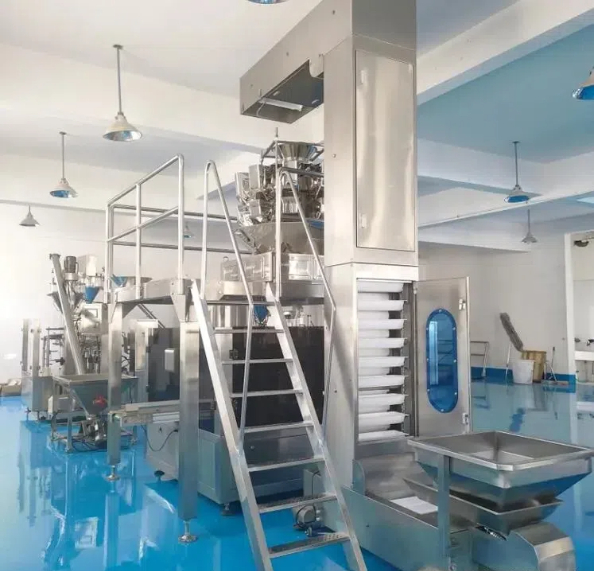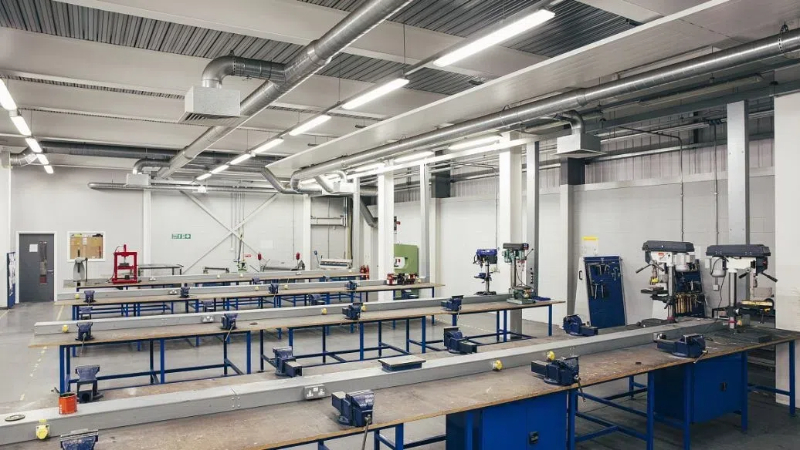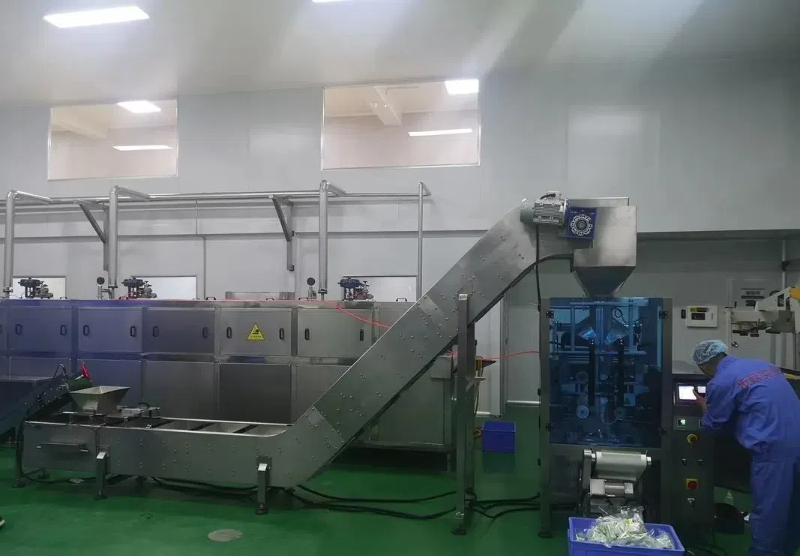
Content Menu
● Introduction
● Understanding Dry Food Packaging Machines
>> Key Components of Dry Food Packaging Systems
● Types of Dry Food Packaging Machines
>> 1. Vertical Form Fill Seal (VFFS) Machines
>> 2. Multihead Weigher Packaging Systems
>> 3. Auger Fillers
>> 4. Volumetric Cup Fillers
● Advantages of Automated Dry Food Packaging Solutions
● Choosing the Right Dry Food Packaging Machine
>> 1. Product Characteristics
>> 2. Production Volume
>> 3. Packaging Material
>> 4. Flexibility and Changeover
>> 5. Integration with Existing Systems
● Innovations in Dry Food Packaging Technology
>> 1. IoT Integration
>> 2. Sustainable Packaging Solutions
>> 3. Advanced Vision Systems
>> 4. Robotics and Artificial Intelligence
● Maintaining Your Dry Food Packaging Equipment
● Case Study: Implementing an Automated Food Packaging Line
● Future Trends in Dry Food Packaging
● Conclusion
● FAQs
>> 1. What is the average lifespan of a dry food packaging machine?
>> 2. How do I determine the right packaging speed for my production line?
>> 3. Can dry food packaging machines handle different package sizes?
>> 4. What are the key factors affecting the accuracy of a packaging machine?
>> 5. How can I ensure my packaging machine meets food safety standards?
Introduction
In today's fast-paced food industry, efficiency and precision are paramount. Dry food packaging machines have become indispensable tools for manufacturers looking to streamline their production processes and meet the growing demand for packaged food products. This comprehensive guide will explore the world of dry food packaging machines, their importance, types, and the latest innovations in the field.
Understanding Dry Food Packaging Machines
Dry food packaging machines are specialized equipment designed to package various dry food products such as grains, cereals, nuts, powders, and snacks. These machines automate the process of measuring, filling, and sealing packages, ensuring consistency, hygiene, and efficiency in food packaging operations.
Key Components of Dry Food Packaging Systems
1. Feeding system
2. Weighing mechanism
3. Filling apparatus
4. Sealing unit
5. Conveyor system
6. Control panel
Types of Dry Food Packaging Machines
1. Vertical Form Fill Seal (VFFS) Machines
VFFS machines are versatile and widely used in the food industry. They form bags from a flat roll of film, fill them with product, and seal them in a continuous process.
2. Multihead Weigher Packaging Systems
These systems use multiple weighing heads to achieve high accuracy and speed in packaging dry foods. They are ideal for products with varying weights or sizes.
3. Auger Fillers
Auger fillers are perfect for packaging powders and fine granules. They use a rotating auger to dispense precise amounts of product into packages.
4. Volumetric Cup Fillers
These machines use pre-measured cups to fill packages with dry foods, ensuring consistent volume across all packages.

Advantages of Automated Dry Food Packaging Solutions
1. Increased production speed and efficiency
2. Improved accuracy in product weight and volume
3. Enhanced food safety and hygiene
4. Reduced labor costs
5. Minimized product waste
6. Consistent packaging quality
Choosing the Right Dry Food Packaging Machine
Selecting the appropriate packaging machine for your dry food products requires careful consideration of several factors:
1. Product Characteristics
Consider the size, shape, and flow properties of your dry food product. Some machines are better suited for powders, while others excel at packaging larger items like nuts or dried fruits.
2. Production Volume
Assess your current and future production needs. High-speed bagging machines are ideal for large-scale operations, while smaller businesses may opt for more compact, versatile solutions.
3. Packaging Material
Different machines are designed to work with specific packaging materials. Ensure the machine you choose is compatible with your preferred packaging type, whether it's plastic bags, pouches, or rigid containers.
4. Flexibility and Changeover
If you package a variety of products, look for machines that offer quick and easy changeovers between different package sizes and product types.
5. Integration with Existing Systems
Consider how the new packaging machine will integrate with your current production line. Look for equipment that can seamlessly connect with your existing conveyor systems and other machinery.
Innovations in Dry Food Packaging Technology
The dry food packaging industry is constantly evolving, with new technologies emerging to meet the changing needs of manufacturers and consumers alike.
1. IoT Integration
Internet of Things (IoT) technology is being incorporated into modern packaging machines, allowing for real-time monitoring, predictive maintenance, and remote operation.
2. Sustainable Packaging Solutions
Many packaging machine manufacturers are developing equipment compatible with eco-friendly packaging materials, responding to the growing demand for sustainable packaging options.
3. Advanced Vision Systems
Cutting-edge vision systems are being integrated into packaging lines to detect defects, ensure proper sealing, and verify product quality throughout the packaging process.
4. Robotics and Artificial Intelligence
Robotic arms and AI-powered systems are enhancing the flexibility and efficiency of packaging operations, particularly in pick-and-place applications and quality control.

Maintaining Your Dry Food Packaging Equipment
Proper maintenance is crucial for ensuring the longevity and optimal performance of your dry food packaging machines. Here are some key maintenance tips:
1. Regular cleaning and sanitization
2. Scheduled lubrication of moving parts
3. Periodic inspection of sealing mechanisms
4. Calibration of weighing systems
5. Timely replacement of wear parts
6. Training operators on proper machine usage and basic maintenance
Case Study: Implementing an Automated Food Packaging Line
Let's examine how a medium-sized snack food manufacturer successfully implemented an automated dry food packaging line to improve their production efficiency.
Company X, a producer of various nut and dried fruit mixes, was struggling to keep up with increasing demand using their manual packaging process. They decided to invest in an automated packaging line consisting of a multihead weigher, a vertical form fill seal machine, and a conveyor system.
Results:
- Production capacity increased by 300%
- Packaging accuracy improved, reducing product giveaway by 2%
- Labor costs decreased by 40%
- Product contamination incidents reduced to zero
This case study demonstrates the significant impact that investing in modern dry food packaging equipment can have on a company's operations and bottom line.
Future Trends in Dry Food Packaging
As we look to the future, several trends are shaping the dry food packaging industry:
1. Increased focus on hygienic design to meet stringent food safety regulations
2. Development of more energy-efficient packaging machines
3. Greater customization options for package designs and sizes
4. Integration of blockchain technology for improved traceability
5. Adoption of augmented reality (AR) for machine maintenance and operator training
Conclusion
Dry food packaging machines play a crucial role in the modern food industry, offering numerous benefits in terms of efficiency, accuracy, and food safety. As technology continues to advance, these machines will become even more sophisticated, helping food manufacturers meet the evolving demands of consumers and regulatory bodies alike.
When considering investing in dry food packaging equipment, it's essential to carefully evaluate your specific needs and choose a solution that aligns with your production goals. With the right packaging system in place, you can significantly enhance your operations, reduce costs, and stay competitive in the ever-changing food market.

FAQs
1. What is the average lifespan of a dry food packaging machine?
Answer: The lifespan of a dry food packaging machine can vary depending on usage, maintenance, and quality. On average, a well-maintained machine can last 10-15 years or more. Regular servicing and timely replacement of wear parts can significantly extend the machine's life.
2. How do I determine the right packaging speed for my production line?
Answer: To determine the right packaging speed, consider your daily production volume, available working hours, and desired output. It's also important to factor in potential downtime for maintenance and changeovers. Consult with packaging machine suppliers to find equipment that matches your specific speed requirements.
3. Can dry food packaging machines handle different package sizes?
Answer: Many modern dry food packaging machines are designed to handle multiple package sizes. Look for machines with quick-change features that allow for easy adjustment of fill volumes and bag dimensions. Some advanced systems can even store multiple product recipes for rapid changeovers.
4. What are the key factors affecting the accuracy of a packaging machine?
Answer: Several factors can impact packaging accuracy, including:
- Product characteristics (size, density, flowability)
- Weighing system calibration
- Machine vibration
- Environmental factors (temperature, humidity)
- Feed rate and consistency
Regular maintenance and calibration are essential for maintaining high accuracy levels.
5. How can I ensure my packaging machine meets food safety standards?
Answer: To ensure food safety compliance:
- Choose machines made from food-grade materials
- Implement regular cleaning and sanitization procedures
- Use machines designed for easy cleaning and inspection
- Maintain proper documentation of cleaning and maintenance activities
- Train operators on food safety protocols
- Consider machines with built-in safety features like metal detection or x-ray inspection systems












